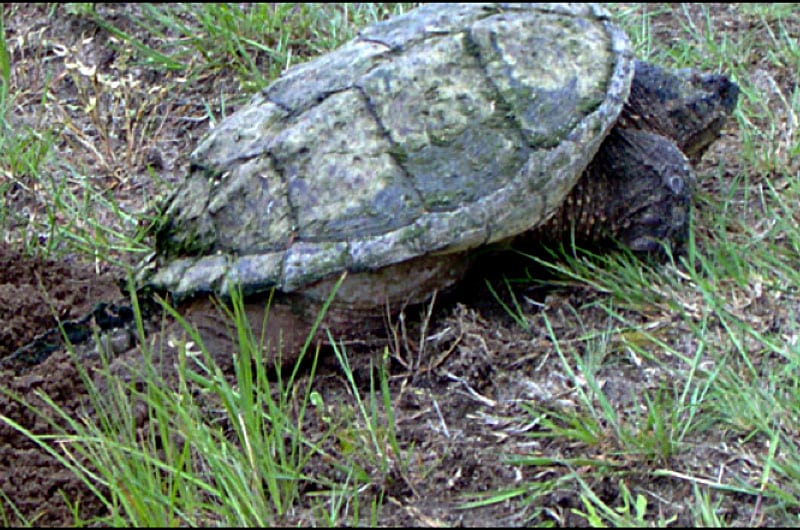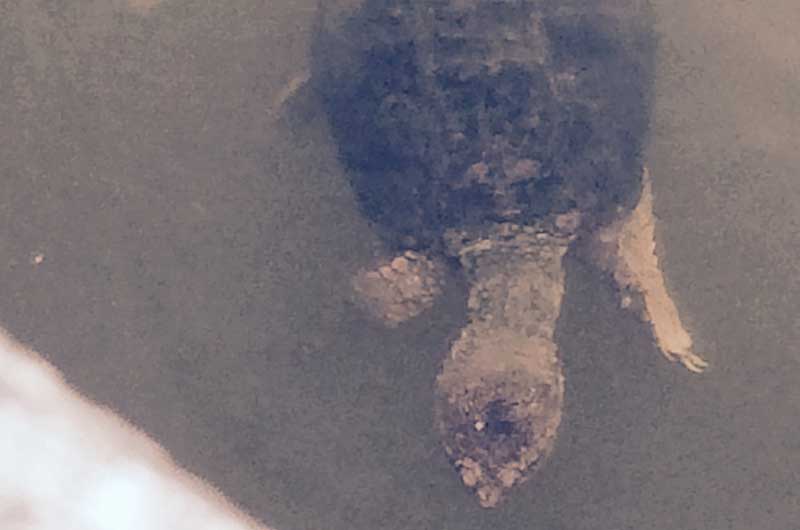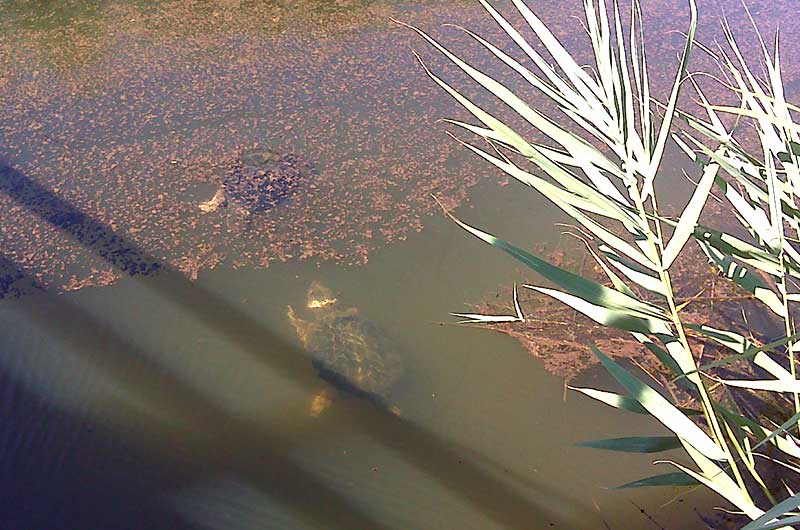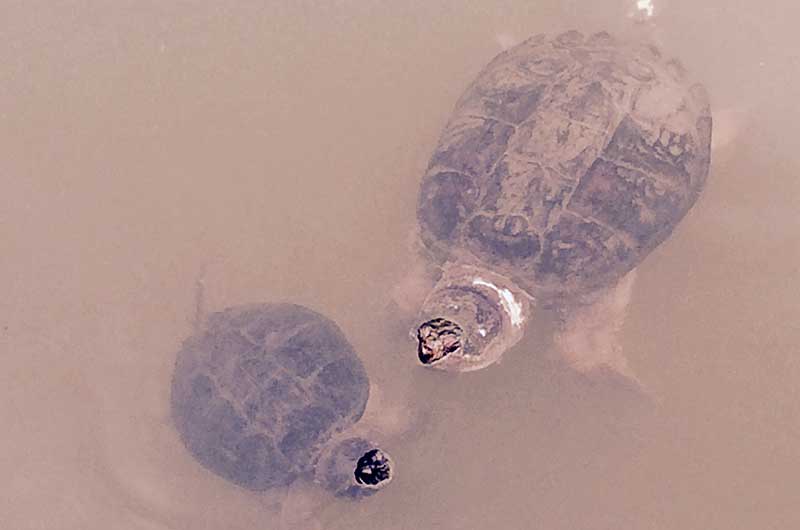~ by Dr. Sarah D. Oktay, Director, University of Massachusetts Nantucket Field Station ~

Last week I went with some of my high school interns to do water sampling at the small bridge located in Madaket at the intersection of South Cambridge Street, Red Barn Road, and Massasoit Bridge Road that goes across the southern end of Long Pond (http://nantucketpondcoalition.com/long/) before it turns into White Goose Cove. We saw a monster; or to be more precise a beautiful, monstrously large snapping turtle, easily the largest one I have seen on Nantucket and obviously one that has been fed for a while. As we were sampling water, a couple of very cute painted turtles poked their heads out of the floating organic debris that builds up under the bridge. A decent sized (probably 30-40 pound) snapping turtle swam by and out of the corner of my eye I saw something very large swim under the bridge. I grabbed my GPS camera and took a couple of very lousy shots of an extremely large snapping turtle with a shell that was approximately two foot across and three feet long weighing around 55-60 pounds with a white necklace-like marking around its neck. I am sure this snapper is well known to area residents and it glided back and forth with its smaller friend keeping an eye out for snacks from above. Male snapping turtles are larger than females so my guess is this is an older obviously well fed male. Speaking of well fed, many Nantucket visitors don’t think of the summer as complete without a trip down to First or Second Bridge off Madaket Road to catch a snapping turtle with a sturdy string and a chicken leg. Each year my interns and I do some water quality sampling in these areas to see what kind of conditions exist around these popular spots. Sometimes we will find bacterial colonies from the chicken used to lure out snappers and fecal coliforms (digestive tract bacteria) from the birds that hang out in the area.
After this memorable encounter (definitely a OMG moment) which was reinforced while encountering the various thoughtful “turtle crossing” signs around the island, I thought this week would be a perfect time to learn about these creatures. I found a wonderful web site http://www.tortoisetrust.org/articles/snappers.htm with tons of snapping turtle information and this delightful quote from DM Carroll’s book The Year of the Turtle: A natural history to get us into the mood: “Snapping turtles, embodiment of turtles who shared the earth with the dinosaurs for a time and are now obliged to share it with the human species, might well report that the former companions were far less stressful.”

Turtles, a generic name for the group of reptiles which includes tortoises and terrapins, are reptiles who typically have bodies shielded by a special bony shell developed from their ribs. All extant, or living, turtles are members of the order Testudines, which includes both living and extinct varieties of turtle. The etymology of the Order name Testudines and the Family Chelydridae are intertwined in a strange chicken versus the egg fashion. The term “chelys” is Greek (Latin version is “testudo”) for “turtle” and was originally known as a stringed musical instrument that had a convex back of tortoiseshell or of wood shaped like the shell. The word “chelys” was used to specifically refer to the oldest lyre of the Greeks, which was said to have been invented by Hermes. According to the Homeric Hymn to Hermes (475), he was attracted by sounds of music while walking on the banks of the Nile, and found they were coming from the shell of a tortoise across which were stretched tendons which vibrated in the wind. The word “chelys” continued to be used for a variety of stringed instruments. The term Chelydra was formed by combining “chelys” with “hydros” for “water serpent” and “serpentina” is Latin for “snake-like” referring to the snake-like neck.
All turtles have a protective shell around their bodies. The top part of their case is called the carapace, the underside is the plastron, and the two are connected by the bridge. Even though they spend large amounts of their lives underwater, turtles are air-breathing reptiles, and must surface at regular intervals to refill their lungs with fresh air. They also spend part of their lives on dry land, although the snapping turtle enjoys staying in water more often than not. The common snapping turtle is not the same critter as the alligator snapping turtle (Macrochelys temminckii), which is even more primordial in appearance and larger. Both species are endemic to the Northern hemisphere and are in the same family, the Chelydridae. The oldest snapping turtle fossil relatives were previously thought to be approximately 65-70 million years old. Those ancient species living in the Paleocene and Late Cretaceous eras had thicker carapaces (top shells) to help ward off the attacks of turtle-eating relatives of the crocodile. Wikipedia tells us that the common snapper’s natural range extends from southeastern Canada, west to the Rocky Mountains, and south through Mexico, and as far south as Ecuador. Snapping turtles are noted for their powerful beak-like jaws and belligerent disposition. They have a muscular build with ridged shells that may measure from 35 cm long in Chelydra species to some 66 cm long in the alligator snapping turtle. The latter species is the largest freshwater turtle in the world, weighing up to 100 kg. The common snapping turtle (Chelydra serpentina serpentina) and its subspecies are much smaller, weighing up to 17 kg in weight with the all-time heaviest clocking in at 39 kg or 86 pounds (https://en.wikipedia.org/wiki/Common_snapping_turtle). The alligator snapping turtle has a much spikier head and body while the common snapping turtle’s body is smoother and less “dinosaur-ish”. In some areas, alligator snapping turtles are hunted for their meat, which is a popular ingredient in turtle soup. Both species can survive for close to 50 years in captivity, while the lifespan of wild individuals is estimated to be around 30 years. They live longer in the northern reaches of their range. A 75 pound adult is a giant and the largest weight for one captured in the wild. Thirty pounds is the average adult size but 40-60 pounders are not uncommon. The one I saw under the bridge is certainly in the 40-60 pound category and technically obese (basically the Marlon Brando of snappers).

All snapping turtles are scavengers, but they will also actively hunt fish, frogs and small mammals. The alligator snapper has a flesh-red, worm-like tongue which it uses to lure fish into its mouth. Young turtles tend to forage actively, while adults tend to lie in ambush. Many individuals can be found within a small range; snapping turtle density is normally related to the amount of available food. The diet of wild young snappers consists mainly of snails, worms, leeches, insects, larvae, small fish and water plants. Adult snappers eat larger prey such as frogs, fish, newts, tadpoles, toads, crayfish, and even snakes, small turtles, small mammals, and young waterfowl like ducklings and goslings. We have seen several “peg-leg” seagulls at the field station, which shows you exactly how dangerous the snappers lurking underwater can be; sometimes a simple dip in fresh water is just not worth it for the birds!
This species mates from April through November, with their peak laying season in June and July. Male snapping turtles are larger than females, and hence courtship is not elaborate (no need for roses or convincing, I guess). The female can hold sperm for several seasons, utilizing it as necessary, which you think would teach the males to be more elaborate in their courtship. There is some “dancing” involved because they tend to communicate to mates with leg movements while facing each other. Females, and presumably also males, in more northern populations mature later (at 15–20 years) and at a larger size than in more southern populations (about 12 years). Females travel over land to find sandy soil in which to lay their eggs, often some distance from the water, up to a mile away has been recorded in some instances. After digging a hole, the female typically deposits her eggs, guiding them into the nest with her hind feet and covering them with sand for incubation and protection. Females produce, at most, one clutch per year, with some females apparently skipping some years. They lay spherical, hard-shelled eggs that average 1.1 in (2.8 cm) in diameter and 0.4 oz (11 g) in mass. Egg size does not seem to increase significantly with female size. Clutch size is highly variable, ranging from six to 109, averaging about 32 across the range, and is positively correlated with female body size, latitude, longitude, and elevation (the largest clutches are laid in northern states with the biggest recorded in western Nebraska). Incubation in nature requires 55–125 days (more typically 75–95) depending on nest temperature (development being faster at higher temperatures) and geography (incubation times being longer in the south). Ernst, Lovich & Barbour report that an incubation temperature of 20° C produces only females, as does 29-31° C. Temperatures in between the two extremes produce both sexes, except 23-24° C which produces only males. Because their clutches are so large, eggs in different parts of the same nest may produce different sex ratios, for example with all females at the top and all males at the bottom.
Hatchling snapping turtles usually emerge from the nest in the late summer and fall (August to October) and move directly to the water. Hatchlings may overwinter in the nest, although that doesn’t always insure survival in a frigid winter. Hatchlings in northern populations that do not emerge in the fall before the onset of cold weather almost never survive the winter, probably because of their low tolerance of subfreezing body temperatures. The picture shows a female at the UMass Boston Nantucket Field Station laying eggs along the roadside. The process took about two hours. On Nantucket, common nesting locations for snapping turtles often coincide with bike paths, driveways and roads which give the new hatchlings a boatload of obstacles to overcome when they hatch and make their way to the water. Sad to say, I have found more than a fair share of tiny pancaked and desiccated hatchlings. Now, when possible, we mark the nest site and keep an eagle eye out for the hatchling’s emergence. Of course, many predators are doing the same thing and hawks and snakes are the main predators who would most enjoy a crunchy snack. The eggs and hatchlings of snapping turtles may be eaten by other large turtles, great blue herons, crows, raccoons, skunks, foxes, bullfrogs, water snakes, and large predatory fish. However, once snapping turtles become larger, there are few animals that prey on them. Snapping turtles may be active at any time of day or night, but nocturnal activity is rare in northern populations. These turtles hibernate at temperate latitudes, but presumably are active year-round at more tropical sites.

I hope you get a chance to go admire these prehistoric beasts down in Madaket or at the Field Station and at various wetlands and ponds on the island. If you see them crossing the road and can safely stop and help, that would be wonderful although don’t encourage them to change direction and keep your fingers and toes out of reach. To learn more, check out this cool website that is also fun for kids: www.chelydra.org/index.html. Portions of this article were originally published in 2009 http://yesterdaysisland.com/archives/science/5.php
References
Ernst, Carl H., Lovich, Jeffrey E. and Barbour, Roger W. 1994. Turtles of the United States and Canada. Smithsonian Institution Press, Washington, D. C.


